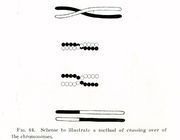Genetic recombination
Genetic recombination is a process by which a molecule of nucleic acid (usually DNA; but can also be RNA) is broken and then joined to a different DNA molecule. Recombination can occur between similar molecules of DNA, as in homologous recombination, or dissimilar molecules of DNA as in non-homologous end joining. Recombination is a common method of DNA repair in both bacteria and eukaryotes. In eukaryotes, recombination also occurs in meiosis where it facilitates chromosomal crossover. The crossover process leads to offspring having different combinations of genes from their parents, and can occasionally produce new chimeric alleles. In organisms with an adaptive immune system, a type of genetic recombination called V(D)J recombination helps immune cells rapidly diversify and adapt to recognize new pathogens. The shuffling of genes brought about by genetic recombination is thought to have many advantages, as it is a major engine of genetic variation and also allows asexually reproducing organisms to avoid Muller's ratchet, in which the genomes of an asexual population accumulate deleterious mutations in an irreversible manner.
In genetic engineering, recombination can also refer to artificial and deliberate recombination of disparate pieces of DNA, often from different organisms, creating what is called recombinant DNA. A prime example of such a use of genetic recombination is gene targeting, which can be used to add, delete or otherwise change an organism's genes. This technique is important to biomedical researchers as it allows them to study the effects of specific genes. Techniques based on genetic recombination are also applied in protein engineering to develop new proteins of biological interest.
Genetic recombination is catalyzed by many different enzymes, called recombinases. RecA, the chief recombinase found in Escherichia coli, is responsible for the repair of DNA double strand breaks (DSBs). In yeast and other eukaryotic organisms there are two recombinases required for repairing DSBs. The RAD51 protein is required for mitotic and meiotic recombination and the DMC1 protein is specific to meiotic recombination.
Contents |
Chromosomal crossover

Chromosomal crossover refers to recombination between the paired chromosomes inherited from each of one's parents, generally occurring during meiosis. During prophase I the four available chromatids are in tight formation with one another. While in this formation, homologous sites on two chromatids can mesh with one another, and may exchange genetic information.
Because recombination can occur with small probability at any location along chromosome, the frequency of recombination between two locations depends on their distance. Therefore, for genes sufficiently distant on the same chromosome the amount of crossover is high enough to destroy the correlation between alleles.
Gene conversion
In gene conversion, a section of genetic material is copied from one chromosome to another, but leaves the donating chromosome unchanged.
Nonhomologous recombination
Recombination can occur between DNA sequences that contain no sequence homology. This is referred to as nonhomologous recombination or nonhomologous end joining.
In B cells
B cells of the immune system perform genetic recombination, called immunoglobulin class switching. It is a biological mechanism that changes an antibody from one class to another, for example, from an isotype called IgM to an isotype called IgG.
See also
- Recombination frequency
- Recombination hotspot
- Four-gamete test
External links
- The Holliday Model of Genetic Recombination
- MeSH Genetic+recombination
- Animated guide to homologous recombination.
References
- Alberts, Bruce (2002). Molecular Biology of the Cell. New York: Garland Science. ISBN 9780815332183.
![]() This article incorporates public domain material from the NCBI document "Science Primer".
This article incorporates public domain material from the NCBI document "Science Primer".
|
|||||||||||